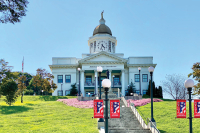Ghost Town owner Harper daunted but not deterred
As Al Harper watched the national recession undermine ticket sales at Ghost Town amusement park over the past two years, he faced a tough choice: pump more money into the faltering theme park or throw in the towel?
Walking away would mean losing the millions he already invested. But investing more could mean throwing good money after bad, with no hope of recouping any of it at the end of the day.
Harper ultimately drew his inspiration from a favorite historical visionary.
“It is kind of fun to do the impossible,” Harper said, quoting the words of Walt Disney, which are inscribed on a plaque he keeps on his desk.
Harper, the 65-year-old owner of the Great Smoky Mountains Railroad and scenic rail lines in Colorado and Texas, wants to revive the bankrupt and beleaguered Maggie Valley theme park.
Harper has been a major backer of Ghost Town since 2006, but he shared ownership with other partners and investors. Under Harper’s rescue plan, he will pay off $7 million of the park’s $13 million in debt — and emerge as the sole owner of the park in exchange.
Related Items
The host of other investors will be cut out and their equity in the park simply evaporate.
“I have lost a lot of money. You have no idea,” said Steve Nichols, an investor from Orlando. “It totally ruined my life.”
Harper will also walk away from more than $5 million in back debt — including hundreds of thousands owed to local businesses, from electricians and plumbers to gas companies and media outlets — which will be wiped away by the bankruptcy court.
Despite the financial carnage in its wake, Ghost Town would avoid the uncertain fate of foreclosure and emerge from bankruptcy with a leader at the helm determined to resurrect the Old West theme park.
“I believe if there is anybody that can pull it off and can keep it as a theme park it is me,” Harper said.
To fund the deal, Harper has lined up a loan with an offshore lender. He said he is “90 percent positive” the loan will come through, hopefully by early June. The Greek financial crisis has come at a bad time, however, and Harper hopes it doesn’t make the lenders nervous.
Harper is putting up the Great Smoky Mountains Railroad as collateral, pledging 100 percent of the railroad’s ownership in exchange for a $15 million loan.
“I am gambling my railroad,” Harper said.
Half the money would be used to buy the park out of bankruptcy, and the other half would sustain operations and bankroll improvements to the park until it begins turning a profit. Harper has built in losses for the first three years, though he hopes to turn it around quicker.
The plan has been approved by the bankruptcy court. All the deal waits on now is the loan to close.
When Ghost Town was put up for sale several years ago, Harper was courted by tourism leaders in the region. Harper originally hoped to be a silent partner with a limited investment.
But the other two partners were unable to raise the cash they promised, and Harper was being pressured to put up more money, he said.
“Right at the beginning they were $2 million short. They said ‘Would you co-sign with us?’” Harper said.
The pattern continued over the next two years as the park struggled to get off the ground and stay afloat.
“I didn’t want to lose the $2 million, so I put in more,” Harper said.
Similar cash calls went out to all the shareholders and investors, but Harper’s deeper pockets left him as the last man standing when the need arose to pitch in more, he said.
Harper ultimately found himself in for more than $4.5 million in loan guarantees — which he is now on the hook for if the park goes under. It’s partly what motivated his plan to buy the park out of bankruptcy.
“Here are my choices. I can forget Ghost Town and write a check for $4.5 million and never look back. Or I can go in and try in this crazy economy to buy Ghost Town,” Harper said. “The easy way out is to walk.
“But this is a lot deeper than that,” said Harper. “My name got attached to it.”
A lot to lose
Several Maggie business leaders are among the ranks of those who will lose shares in the park, but those interviewed for an article last week don’t see their investments as being for naught. As long as Ghost Town continues to operate and bring in tourists, they believe their contribution helped the greater community, even if they personally have nothing to show for it.
A handful of investors from out of state who put up capital for the park’s purchase in 2006 are not feeling so rosy by what they see as an end-run by Harper. But they are helpless to do anything about it.
“I don’t think there is anything I can do other than write it off as a bad investment,” said Court Huish, an investor from California. “That’s just business.”
Jeff Anderson, an investor from Florida, will lose a substantial six-figure investment.
“I am not happy with what has transpired, but it is what it is. The bankruptcy court is the bankruptcy court,” Anderson said.
Nichols not only stands to lose his six-figure investment as a shareholder, but he is also on the hook for a portion of the park’s mortgage, a portion of which he personally guaranteed.
Ghost Town took out a loan of $9.5 million with BB&T in 2006. Harper’s deal will only pay off $7 million — leaving BB&T short by $2.5 million. Naturally, BB&T is coming after Nichols to make good on the portion he signed a personal guarantee for. Nichols wouldn’t say for just how much.
“The nail is in the coffin. They may as well throw the dirt on,” Nichols said.
Nichols said the owners kept returning to investors asking them to put up more to keep the park afloat, but he didn’t have any more.
“It’s not that we don’t care,” Nichols said. “I think Ghost Town is a wonderful place, but if you haven’t got the money you haven’t got the money.”
Besides, the shareholders weren’t given a say in park operations, like the large amount of the money spent on upgrades the first two years after reopening. The 1960s-era amusement park was plagued by crumbling infrastructure, from a jury-rigged electrical system to malfunctioning rides. Putting the park in order required a “big capital burn” and dug a hole it couldn’t emerge from, Nichols said.
“I think they tried to fix too many things too fast instead of little by little,” Nichols said.
Anderson agreed, to a point.
“To suggest the sole reason for the failure of the park to perform was because of the capital over-expenditure is ridiculous. As with everything that fails, there is not one reason, there is multiple,” Anderson said.
Nichols said the park has the potential to make money, but luring visitors was ultimately the main challenge.
“If you don’t have enough people coming, what are you going to do? It’s Business 101,” Nichols said.
Particularly in the days of Six Flags, Busch Gardens and Carowinds.
“That stuff wasn’t there back in the 1970s,” Nichols said.
Harper estimates it will take 150,000 visitors a year to make the park profitable. It brought in just 71,000 last year while suffering from the negative publicity of bankruptcy and spending no money on advertising.
As a sole owner, Harper said he will have the control he needs to make the park work — control he didn’t have under the old entity. Harper points to his success with the Great Smoky Mountains Railroad, even during the recession.
“My worst year ever I put 150,000 people on a train,” Harper said. Harper plans to cross-market with the railroad to send visitors Ghost Town’s way. He will also combine functions like payroll, accounting and ticket sales, saving hundreds of thousands, he said.
Huish, Nichols and Anderson say they were not properly kept apprised of unfolding events, like Harper’s bid to buy the park.
All three were all brought to the table as investors by Hank Woodburn, one of the lead buyers in 2006. Woodburn comes from the amusement industry, operating a network of 10 fun parks with water parks, mini golf, laser tag, go-carts and the like under the company Adventure Landing. Woodburn also recruited Harper to the deal.
Woodburn, who will lose substantially in the deal, did not return messages.
Moving on
Harper doesn’t see his deal as ruthless. The alternative was foreclosure, and under that scenario, the investors would likewise lose all their money and the small businesses still would go unpaid. Under Harper’s plan, at least Ghost Town has a shot at staying an amusement park.
Harper could theoretically use part of the $15 million loan he is taking out to pay back those left holding the bag. But divesting the park of its old debt is key to Harper’s business plan.
“I can’t pay for all the mistakes that happened in the past,” Harper said. “It is a tragedy that it ended up like it ended up.”
Harper said he is not exactly a winner in whole deal. He’s taking on a major new venture at the age of 65 — a defensive but risky strategy to protect the investment he already sunk into the park. In addition to the $7 million Harper will pay for the BB&T bank mortgage, he is on the hook for $2 million on an outside loan to fund improvements at the park that he co-signed for — which must be paid separately.
“I could take the approach I was a victim. But the world is full of victims,” Harper said. “I made mistakes, so I am going to correct them. I am going to make this thing work. We have got to move forward and get this past behind us.”
Getting the park open
A deal to bail Ghost Town out of bankruptcy court is contingent on a loan from an offshore lender.
If it goes through, the park could be open by the beginning of July, according to Ghost Town’s CEO Steve Shiver. Shiver told a group of business owners last week that there is a lot to do to get the park open for the season. Once the loan comes through, work can begin.
Workers must be hired and trained to run the park, but the biggest challenge will be getting the grounds, rides and facilities ready. Shiver laid out a long list of needed repairs, including replacing water pipes that froze and broke over the winter and two broken water pumps that move water around the mountaintop. Winter even took its toll on the rides, some of which need retrofitting now, Shiver said. The major rollercoaster, which opened only for a short time last season, has inspection hurdles to pass once more.
One issue to contend with will be nearly $400,000 in debt from 2009. The long list includes paying off at least $30,000 in utility bills from 2009 to get water and power restored.
It is also unclear whether the park could reopen until the mountainside below, which was destabilized by a mudslide, is shored up.









